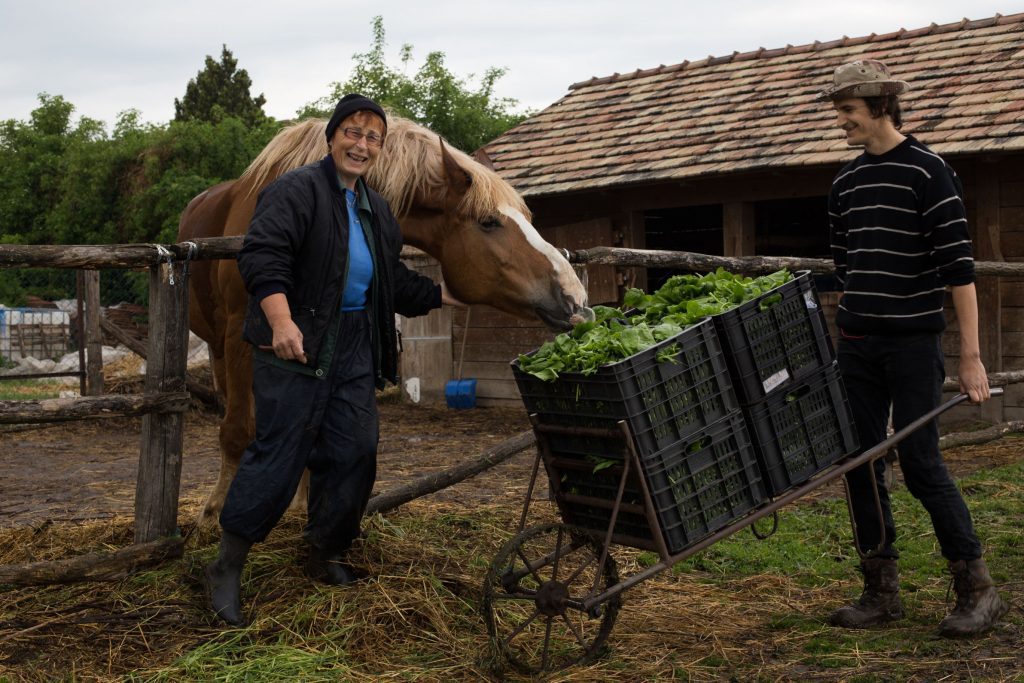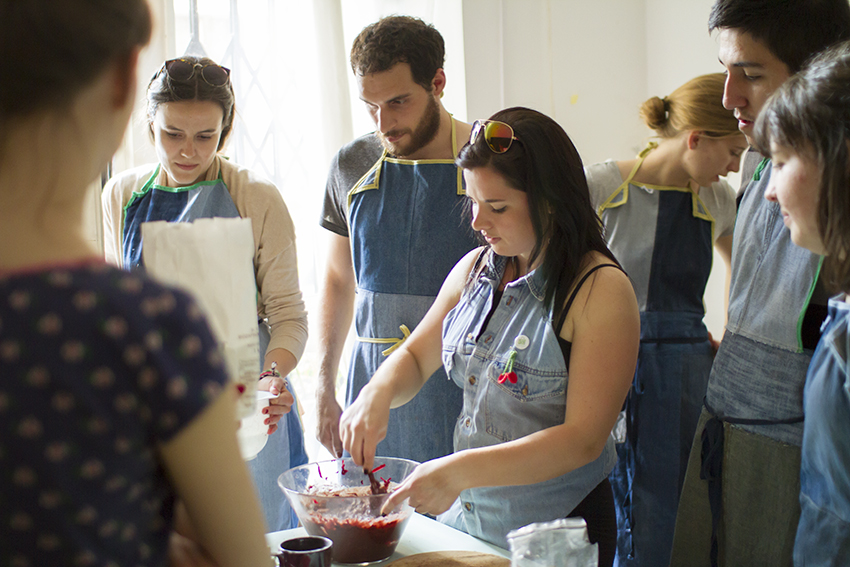Szatyorbolt has been operating an association and a food shop within a Community Supported Agriculture (CSA) scheme for the past 9 years. The shop’s aim is to bring local produce from the countryside to the city, by connecting consumers with small and mid-size farms and food producers within a radius of 50-70km from Budapest. Establishing new, sustainable and equitable model of food distribution in Hungary, Szatyorbolt now works with around 100 farmers annually.
By Isaac Guzman Estrada on the basis of an interview with Era Kármán on 21 April 2017
Community Supported Agriculture can be explained as an alternative mode of obtaining raw vegetables and fruits. It is based on a local agriculture and food distribution-retailing model. However, it is not reduced to the economic exchange between the farmers and the costumers. Contrary to the ‘traditional’ urban purchase model of groceries, in a supermarket, where the vegetables and fruits can be found perfectly aligned, without any trace of dirt, or even without imperfections, CSA seeks to bridge the gap between those who produce and those who consume, bringing fresh vegetables to the citizens from the farmers’ hands. In addition, it creates a partnership between a farm and consumers where the risks and rewards of farming are shared.

There are different business models within CSA. The European Handbook for CSA identifies four main types. Partnership is a commitment contract between consumer and producer who buy and sell of food products. The Local model integrates local producers into the economy. The Solidarity model is an accord between the consumers and producers to support each other, especially sharing the risk (weather, seasonality, harvest, costs) by paying upfront a fixed sum that to enables the farm to maintain production. The Producer-consumer tandem is based on direct contact without intermediaries. In reality, most SCA arrangements combine various features of these models.
Community Supported Agriculture has proven to create benefits on all sides. CSA systems help consumers can access fresh food from a known source; they reduce ‘food miles’, involve mostly organic and non-intensive farms and require less packaging; they support local economy, local consumption, employment and education; the secure an income to farms allowing them to elaborate a business plan according to their yield, sales and costs on a fairer base; and they create a greater involvement with the local community. In summary, CSA breaks the barriers between producers and consumers, promoting a more cooperative model of food distribution at the city-region level.
Szatyorbolt, an experience from Budapest
Located in Budapest, Szatyorbolt promotes the values of locality, seasonality, organic quality, environment-friendliness and community support by operating a food store as well as a non-profit association that organises workshops and educational trainings about conscious consumption and food distribution in city. The shop is open to anyone and offers a wide variety of environmental friendly products, such as cleaning products, non-fresh organic food, beers, wine, seeds, and organic food-oriented books.

In addition, Szatyorbolt runs a vegetable box delivery system. It works in a simple way: after registration, the customer can place an order of a small box (10 EUR for around 2.5 kg of vegetables and fruits) or a big box (19.50 EUR for 5kg of produce). The vegetables change every week, following the logic of seasonality. The website shows in advance the vegetables that will be in the box. It is also possible to add other products to the box, more vegetables or any other product that the shop offers, including bread, sausages, cleaning products. Every Thursday, staff and volunteers gather at the shop to receive the vegetables from the different farms and start to pack the vegetable boxes, up to 70 to 100 boxes in a day. They start with the ‘regular’ orders, followed by specific requests, according to each customer’s preference made at the time of the order. On Thursdays and Fridays, customers can pick-up their boxes either in the Szatyorbolt shop or in one of the different pick-up points around the city, or receive them by home delivery.
When Szatyorbolt started, the founders – a group of people sharing an interest in environmental issues – wanted to move away from the ‘traditional’ food trade system. They looked for a trustable source of food close to the city and approached the farmers with the idea of bringing local producers to the city, with a fairer economic scheme. The began to sell food through the vegetable box scheme. Soon they realised that they needed a ‘structure’ to facilitate their operations, make their financial transactions more transparent and increase their hygienic standards. The idea to establish the store was also influenced by the notion that to raise awareness and to expand Szatyorbolt’s operations beyond a circle of like-minded individuals, a more accessible distribution channel is needed, reaching those with no specific commitment but with a demand for fresh, healthy, good quality food. Selling only local produce has a limited profit margin at it represented a significant financial burden on the store, especially given the low prices prioritised by Szatyorbolt. In order to create a solid economic model for the shop, its operators decided to widen the variety of their products, also including organic produce from beyond the region.
Making Szatyorbolt work required a shift of mindsets on all sides. Farmers were used to work in a system where intermediaries go to farms and try to buy produce as cheap as possible in order to create a high profit margin by selling them in the city. For them, it was not easy to understand that Szatyorbolt does not work towards high profits but a fair price for both farmers and the consumers. In order to avoid internal competition, Szatyorbolt does not invite many farmers who produce the same vegetables or fruits. This arrangement creates an additional trust between farmers and the organisation, and Szatyorbolt regularly asks farmers to accept visits from their side, to see how they are working but also to bring groups of people to the farms for educational purposes. The mainstreaming of local-organic products can lead to, some kind of, ‘elitist’ access of those who has the financial possibilities to purchase eco-friendly products.
Buy and consume local

Szatyorbolt’s implementation of the model of Community Supported Agriculture offers an innovative economic approach building on mutual commitment and the sharing of risks and rewards. The CSA scheme also help promoting local and peri-urban agriculture; Budapest is in a relatively fortunate situation as there is significant agricultural production in the city’s close proximity. Organising a short supply chain can also provide the context for innovation in terms of communication and transparency. For instance, Szatyorbolt began to provide labels to indicate where certain produce originate, challenging customers to be more aware of the provenance of their food and include this information in their decisions about where and what to buy.
Transparency, accountability and community involvement are key to Szatyorbolt’s success, and so is affordability. Although the mainstreaming of local-organic products can lead to a reduced access from the side of less affluent social groups, the organisation’s community involvement scheme provides a wide access to fresh local produce. In the long term, better awareness of food resources and more knowledge about how food distribution works can go beyond changing consumer behaviour and can have an impact on urban and regional planning as well.
References
Bashfor J. et al. (2013). European Handbook on Community Supported Agriculture. Sharing experiences. Community Supported Agriculture for Europe Project. Vienna.
Cone C. and Myhre A. (2000) Community-Supported Agriculture: A Sustainable Alternative to Industrial Agriculture?. Human Organization: Summer 2000, Vol. 59, No. 2, pp. 187-197.
Schnell S. (2007) Food with a farmer’s face: Community-supported agriculture in the United States. Geprgaphical record. The Georaphical review. pp. 550-564.


